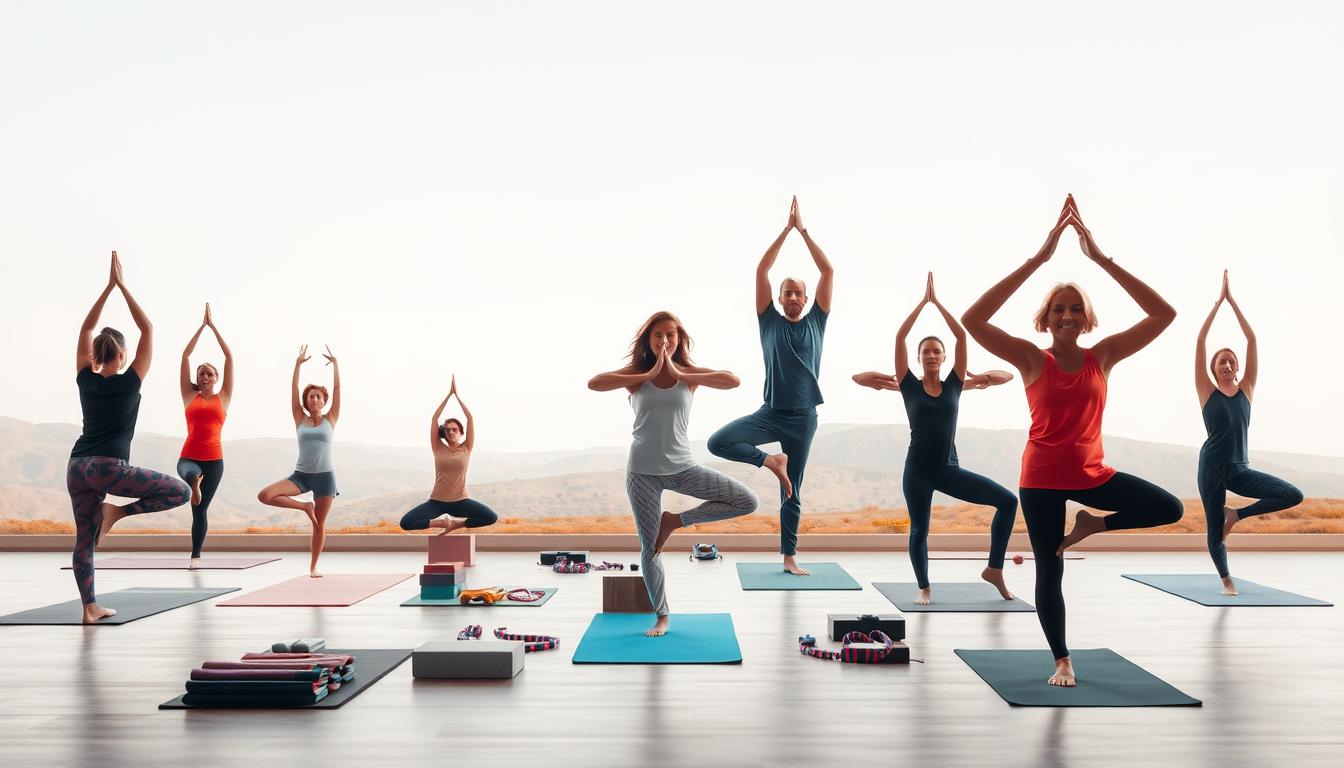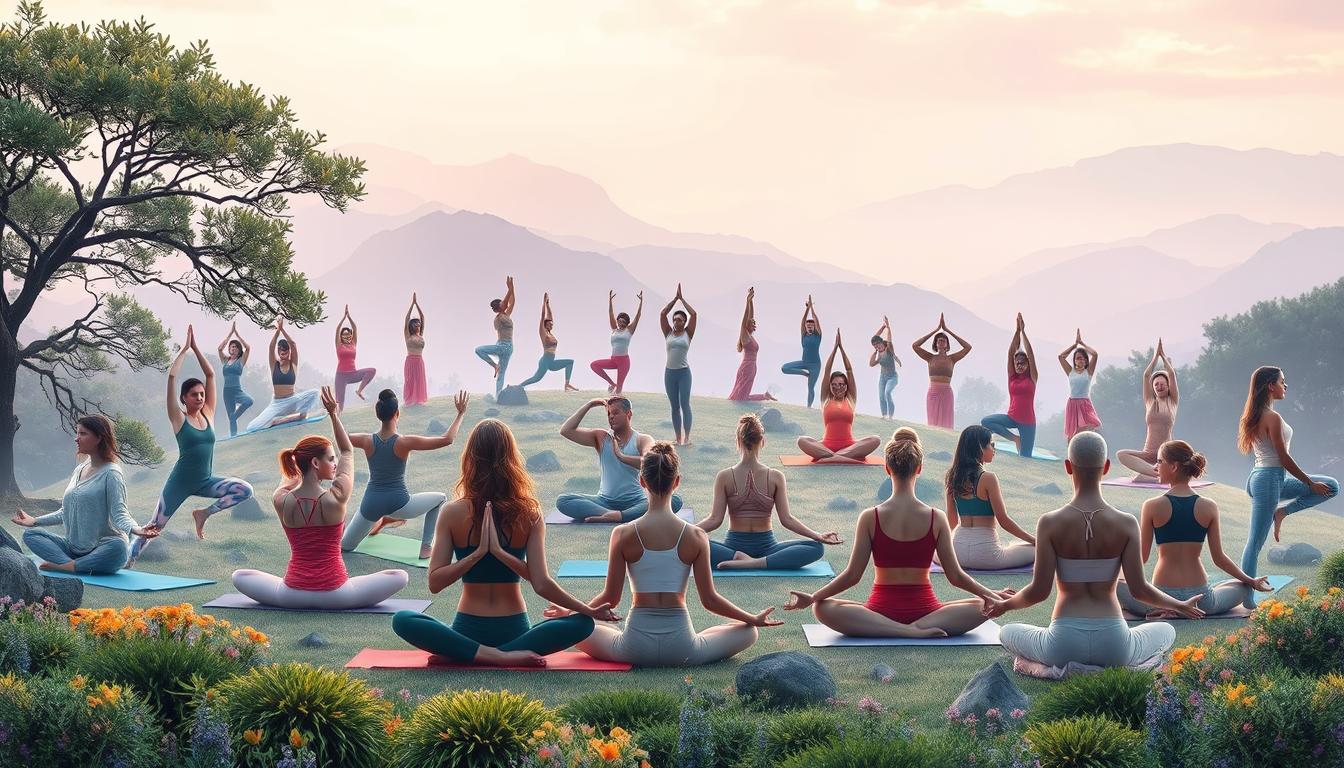
The world of yoga is vast and diverse, offering numerous styles and practices tailored to different needs and preferences. With various yoga styles emerging over time, it can be challenging to navigate the options.
This article aims to provide a comprehensive guide to the different types of yoga, helping you understand their unique characteristics and benefits. Whether you’re a seasoned yogi or just starting out, discovering the right yoga practice can enhance your lifestyle and help you achieve your goals.
By exploring the diverse world of yoga, you can make an informed decision about which style suits you best.
The Diverse World of Yoga
The world of yoga is incredibly diverse, with numerous styles and disciplines that cater to different needs and preferences. This diversity is a result of yoga’s evolution over thousands of years, influenced by various cultural and philosophical traditions.
Ancient Origins and Modern Evolution
Yoga originated in ancient India over 5,000 years ago, with its roots in Hindu philosophy. The modern yoga landscape is a reflection of this ancient practice, evolved and adapted to suit contemporary needs. Traditional yoga focused on spiritual growth and self-realization, while modern yoga often emphasizes physical postures and well-being.
The evolution of yoga has led to the development of various styles, each with its unique focus and techniques. For instance, some styles like Ashtanga and Vinyasa focus on dynamic movements, while others like Yin and Restorative yoga emphasize static postures and relaxation.

Why So Many Variations Exist
The numerous variations of yoga exist due to different interpretations and adaptations of traditional yoga practices. Modern fitness trends and cultural exchange have also influenced the development of new yoga styles. Some of the key factors contributing to the diversity of yoga include:
- Cultural and philosophical influences
- Adaptation to modern lifestyles and needs
- Innovations in yoga teaching and practice
- Integration of other fitness and wellness disciplines
This diversity allows practitioners to choose a style that suits their goals, preferences, and abilities, making yoga accessible to a wide range of people.
How Many Yoga Types Are There? Understanding the Main Categories
Understanding the different categories of yoga can help practitioners choose the most suitable style for their needs. Yoga has been categorized and re-categorized over the years, leading to a diverse array of styles and practices.
Traditional vs. Modern Classifications
Traditionally, yoga is understood through its classical branches, which provide a foundational understanding of yoga’s diverse practices. In contrast, modern classifications often focus on the level of intensity, teaching methodology, or specific focuses like alignment or flow.
Traditional classifications offer a deeper understanding of yoga’s roots and philosophical underpinnings. Modern classifications, on the other hand, cater to contemporary needs and preferences, making yoga more accessible to a broader audience.
The Six Classical Branches of Yoga
The six classical branches of yoga are Hatha, Raja, Bhakti, Jnana, Karma, and Tantra yoga. Each branch represents a unique approach to yoga, encompassing physical postures, meditation, and philosophical study.
- Hatha Yoga: Focuses on physical postures and breathing techniques.
- Raja Yoga: Emphasizes meditation and the eightfold path to achieving yoga.
- Bhakti Yoga: Cultivates devotion and love.
- Karma Yoga: Practices selfless action and service.
- Tantra Yoga: Incorporates rituals and practices aimed at spiritual growth.
| Classical Branch | Focus | Key Practices |
|---|---|---|
| Hatha Yoga | Physical postures and breathing | Asanas, Pranayama |
| Raja Yoga | Meditation and eightfold path | Meditation, Ethical living |
| Bhakti Yoga | Devotion and love | Prayer, Chanting |
Modern Categorization Approaches
Modern yoga styles often blend elements from the classical branches with contemporary preferences. Styles like Vinyasa Flow, Ashtanga, and Iyengar yoga have gained popularity, focusing on aspects such as flow, intensity, and alignment.
By understanding both traditional and modern categorizations, practitioners can navigate the diverse world of yoga more effectively, choosing practices that resonate with their goals and preferences.
Popular Yoga Styles for Every Practitioner
The world of yoga is vast and diverse, offering numerous styles to suit different needs and preferences. Whether you’re a beginner or an advanced practitioner, understanding the various yoga styles can help you choose a practice that aligns with your goals, fitness level, and preferences.
Hatha Yoga: The Foundation
Hatha yoga is a traditional and classical form of yoga that focuses on physical postures (asanas) and breathing techniques (pranayama). It aims to balance the body’s energy and prepare it for meditation. Hatha yoga is an excellent starting point for beginners, as it introduces the fundamental principles of yoga.
Vinyasa and Flow-Based Practices
Vinyasa yoga, also known as flow yoga, is a dynamic style that links movement with breath. It involves synchronizing breath with a series of poses, flowing from one to another. This style is great for those who enjoy movement and are looking for a more energetic practice. Vinyasa yoga can help improve cardiovascular health, flexibility, and coordination.
Ashtanga and Power Yoga
Ashtanga yoga is a fast-paced, physically demanding style that involves a set sequence of poses. It’s designed to build internal heat, strength, and flexibility. Power yoga is a more intense and dynamic version of Ashtanga yoga, focusing on building strength, endurance, and flexibility. Both styles are ideal for those who enjoy a challenging practice.
Iyengar and Alignment-Focused Styles
Iyengar yoga emphasizes precise alignment, the use of props, and the development of strength, balance, and flexibility. It’s a great style for those who value attention to detail and are looking to improve their posture and alignment. Iyengar yoga is known for its therapeutic benefits, making it suitable for practitioners with injuries or limitations.
Restorative and Gentle Approaches
Restorative yoga is a gentle and therapeutic style that involves using props to support the body in relaxing postures. It’s designed to promote relaxation, rejuvenation, and restoration. This style is perfect for those who need to unwind, are recovering from an injury, or are looking for a more meditative practice.
In conclusion, the diverse yoga methods available today cater to a wide range of needs and preferences. By exploring the different kinds of yoga, you can find a practice that suits your lifestyle, goals, and fitness level. Whether you’re looking for a physically demanding practice or a more gentle approach, there’s a yoga style to suit your needs.
Specialized and Emerging Yoga Practices
Beyond the traditional yoga styles, there are many specialized and emerging practices worth exploring. These modern variations offer unique benefits and cater to diverse needs, enhancing the overall yoga experience.
Hot Yoga Variations (Bikram and Beyond)
Hot yoga, including Bikram yoga, has gained popularity for its challenging and detoxifying practice. Performed in a heated environment, hot yoga promotes sweating, which is believed to aid in cleansing the body. Bikram yoga, a style of hot yoga, involves a set sequence of postures and is known for its intense physical demands.
Other hot yoga variations offer similar benefits, with some modifying the sequence or temperature to suit different practitioners. These styles are ideal for those seeking a physically demanding practice that also promotes mental focus.
Kundalini and Spiritual-Focused Yoga
Kundalini yoga is a spiritual-focused practice that aims to release energy in the body through postures, breathing techniques, and meditation. This style emphasizes the awakening of Kundalini energy, believed to reside at the base of the spine, promoting spiritual growth and self-awareness.
Kundalini yoga is characterized by its use of breathwork, chanting, and meditation, making it a holistic practice that addresses both physical and spiritual well-being.
Aerial and Acrobatic Yoga
Aerial and acrobatic yoga incorporate props and creative sequences, offering a dynamic and physically demanding practice. Aerial yoga uses silk hammocks or swings to support the body in various postures, while acrobatic yoga involves partner work and acrobatic poses, promoting trust, strength, and flexibility.
Therapeutic and Adaptive Yoga
Therapeutic and adaptive yoga cater to specific needs, such as injury rehabilitation or accessibility. These practices modify traditional yoga postures to accommodate different abilities, making yoga more inclusive. Therapeutic yoga focuses on healing and rehabilitation, while adaptive yoga adjusts practices to suit individual needs.
Fusion and Modern Interpretations
Fusion yoga combines different styles, creating a unique and dynamic practice. This modern approach allows practitioners to experience a variety of yoga styles in one class, keeping the practice fresh and engaging. Examples include combining Vinyasa flow with restorative yoga or integrating elements of Pilates with yoga.
- Fusion yoga offers a versatile practice that can be tailored to individual preferences.
- It allows for creativity and innovation in yoga instruction.
- Practitioners can benefit from multiple yoga styles in a single practice.
Conclusion: Finding Your Ideal Yoga Practice
With numerous yoga styles available, discovering the right practice can be a journey of self-discovery. Understanding the different styles, their unique characteristics, and benefits enables you to make an informed decision about which practice suits your needs.
Whether you’re seeking a physically demanding style, a meditative approach, or a therapeutic practice, there’s a yoga style to match your goals. As you explore the diverse world of yoga, remember that the ultimate goal is to cultivate physical, mental, and spiritual well-being.
By embracing the various yoga styles and practices, you can deepen your understanding of yourself and the world around you. So, explore the many yoga types, and find the one that resonates with you, answering the question of how many yoga types are there with a personal discovery.
FAQ
How many yoga types are there?
There are numerous yoga types, with various sources categorizing them into different numbers. Traditionally, yoga is categorized into six main branches, while modern times have seen the emergence of many more styles.
What are the main categories of yoga?
The six classical branches of yoga are Hatha, Raja, Bhakti, Jnana, Karma, and Tantra yoga. Modern categorization approaches also recognize various styles, such as Vinyasa, Ashtanga, Iyengar, and Restorative yoga.
What is the difference between traditional and modern yoga classifications?
Traditional yoga classifications refer to the six classical branches, while modern classifications often focus on the level of intensity, focus, or teaching methodology.
What are some popular yoga styles for beginners?
Hatha yoga, Vinyasa yoga, and Restorative yoga are popular styles for beginners, as they offer a gentle and foundational introduction to yoga practices.
Are there yoga styles that cater to specific needs or goals?
Yes, there are various yoga styles that cater to specific needs, such as therapeutic yoga for injury rehabilitation, adaptive yoga for accessibility, and hot yoga for detoxification.
Can I combine different yoga styles to create a unique practice?
Yes, many yogis combine different styles to create a practice that suits their needs and goals. This is often referred to as fusion yoga.
How do I choose the right yoga style for me?
By understanding the different yoga styles, their unique characteristics, and benefits, you can make an informed decision about which practice is right for you. It’s essential to explore and find what works best for your lifestyle, goals, and preferences.





![Maternity Ward at [Hospital Name] – Exceptional Care](https://zyplin.com/wp-content/uploads/2025/06/fe0f7353-210f-4c41-be1a-1f81eae63528.jpg)

